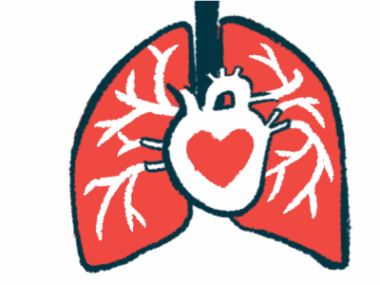RV Damage on MRI Linked to Heart Events in Cardiac Sarcoidosis
Right ventricle scarring is strong predictor of heart-related death
Written by |

Findings of defects in the heart’s right ventricle, as assessed with an MRI scan, can predict the occurrence of cardiovascular events in people with confirmed or suspected cardiac sarcoidosis, a review study showed.
Particularly, scarring in the right ventricle muscle was a “strong independent predictor” of sudden heart-related death, according to researchers, who noted that such damage could be used to accurately identify patients at highest risk of such death.
“The presence of [right ventricle] dysfunction … was statistically significantly associated with adverse outcomes, including all-cause death, adverse cardiovascular endpoint, and [sudden cardiac death],” the team wrote.
The review study, “Prognostic Value of RV Abnormalities on CMR in Patients With Known or Suspected Cardiac Sarcoidosis,” was published in the journal JACC: Cardiovascular Imaging.
Assessing right ventricle damage in the heart via MRI
Sarcoidosis is marked by the formation of small clumps of inflammatory cells, called granulomas, in the body’s tissues and organs. These granulomas disrupt their function. When they form in the muscles of the heart, it’s called cardiac sarcoidosis, and these clumps can lead to irregular heartbeat, heart failure, and sudden heart-related death.
As such, “early recognition of high-risk patients with CS [cardiac sarcoidosis], especially those at risk of sudden cardiac death (SCD), and the timely initiation of therapy … for the prevention of SCD, are important,” the researchers wrote.
MRI studies have shown that abnormalities in the heart’s left ventricle, which pumps oxygen-rich blood to the body, are associated with cardiovascular events and death by any cause (all-cause death) in cardiac sarcoidosis patients.
However, abnormalities in the right ventricle (RV), which pumps oxygen-depleted blood to the lungs, have not been thoroughly examined in relation to heart-related outcomes in this patient population.
Now, an international team of researchers retrospectively analyzed studies published between 2012 and 2021 that reported the potential predictive potential of RV abnormalities in people with known or suspected cardiac sarcoidosis.
RV abnormalities included two MRI-assessed heart measures: right ventricular ejection fraction (RVEF) and late gadolinium enhancement (RV-LGE). RVEF is an indicator of right ventricular function, while RV-LGE can be used to detect scarring, or fibrosis, in the right ventricle muscle.
Eight studies, involving a total of 899 people with confirmed or suspected cardiac sarcoidosis, were included in the meta-analysis. The patients’ mean age was 54.3 and 376 (41.8%) were men. The average follow-up was 3.2 years.
The researchers looked at a composite outcome that included all-cause death and cardiovascular events, such as hospitalization for heart failure, pacemaker implantation, and heart-related death. Sudden cardiac death and aborted SCD, meaning resuscitation after a cardiac arrest, also were included as outcomes.
Pooled results showed that 23.9% of patients (173 individuals) had right ventricle dysfunction, based on RVEF values, while 15.6% (113 patients) had RV scarring according to RV-LGE.
RVEF-based studies indicated that, during follow-up, the composite outcome occurred in 65 of 435 cases (14.9%), while 51 of 641 cases (8%) experienced sudden heart-related death or had aborted SCD.
Patients with right ventricle dysfunction had a threefold higher risk of both the composite outcome and SCD-related outcomes than those with normal RVEF.
The rate of combined cardiovascular events and all-cause death per year was significantly higher for patients with right ventricle dysfunction than for those with normal RVEF (11.1% vs. 2.3%). Similar findings were observed for the rate of sudden death and aborted sudden death (7.1% vs. 1.4%).
Across studies with RV-LGE data, the composite outcome occurred in 32 of 84 patients (38.1%) with right ventricle scarring compared with 16 of 152 cases (10.5%) without scarring. A total of 41 of 113 patients (36.3%) with right ventricle scarring experienced SCD-related events compared with 21 of 464 (45.2%) without RV scarring.
The presence of RV scarring was associated with a nearly five times greater risk of cardiovascular events or all-cause death, and a nearly 10 times higher risk of SCD-related events.
Compared with patients without abnormal RV-LGE, those with RV scarring experienced more composite outcome events (14.4% vs. 3%) and SCD-related events (12.4% vs. 1.3%) per year.
Early recognition of high-risk patients with CS [cardiac sarcoidosis], especially those at risk of sudden cardiac death (SCD), and the timely initiation of therapy … for the prevention of SCD, are important.
Statistical analyses showed that the presence of right ventricle dysfunction of the heart could accurate identify patients who experienced composite outcome events with 76% accuracy, while RV scarring could identify those with SCD-related events with 83% accuracy.
“In patients with known or suspected CS, the presence of RV LGE and reduced RV systolic function on [heart MRI] markers provided significant prognostic value in predicting all-cause death, adverse cardiovascular events, and SCD (or aborted SCD),” the researchers wrote.
“Furthermore, RV LGE was highly associated with SCD in patients with known or suspected CS, raising the potential for future clinical guidance to include ICD [implantable cardioverter defibrillator] placement in the treatment of CS patients in the presence of RV LGE,” they concluded.
ICD is a device that delivers electrical shocks to restore the heart’s normal heart rhythm.





